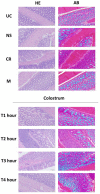The Influence of Feeding with Colostrum and Colostrum Replacer on Major Blood Biomarkers and Growth Performance in Dairy Calves
- PMID: 36851432
- PMCID: PMC9965887
- DOI: 10.3390/vetsci10020128
The Influence of Feeding with Colostrum and Colostrum Replacer on Major Blood Biomarkers and Growth Performance in Dairy Calves
Abstract
Bovine colostrum (BC) is the first milk produced by lactating cows after parturition. BC is rich in various amino acids, proteins, and fats essential for the nutrition of the neonate calves. Despite the evident beneficial effect of BC on calves, the effect of BC on blood biomarkers is poorly understood. Calves that received BC showed significantly higher body mass at days 7 and 30 (38.54 kg and 43.42 kg, respectively) compared to the colostrum replacer group (p = 0.0064). BC induced greater quantities of blood neutrophils (0.27 × 109/L) and monocytes (4.76 × 109/L) in comparison to the colostrum replacer (0.08 and 0.06 × 109/L, respectively) (p = 0.0001). Animals that received BC showed higher levels of total serum protein (59.16 g/L) and albumin (29.96 g/L) in comparison to the colostrum replacer group (44.34 g/L and 31.58 g/L, respectively). In addition, BC induced greater intestinal mucus production in the Wistar rat model. Collectively, these results demonstrate that BC is important for the growth of calves and that it provides a significant beneficial effect on morphological and biochemical blood parameters.
Keywords: biomarkers; bovine colostrum; calf; immunomodulation; maternal milk; neutrophils.
Conflict of interest statement
The authors declare no conflict of interest.
Figures









References
-
- Godden S.M., Smolenski D.J., Donahue M., Oakes J.M., Bey R., Wells S., Sreevatsan S., Stabel J., Fetrow J. Heat-Treated Colostrum and Reduced Morbidity in Preweaned Dairy Calves: Results of a Randomized Trial and Examination of Mechanisms of Effectiveness. J. Dairy Sci. 2012;95:4029–4040. doi: 10.3168/jds.2011-5275. - DOI - PubMed
-
- Zarei S., Reza Ghorbani G., Khorvash M., Martin O., Hossein Mahdavi A., Riasi A. The Impact of Season, Parity, and Volume of Colostrum on Holstein Dairy Cows Colostrum Composition. Agric. Sci. 2017;8:572–581. doi: 10.4236/as.2017.87043. - DOI
Grants and funding
LinkOut - more resources
Full Text Sources

